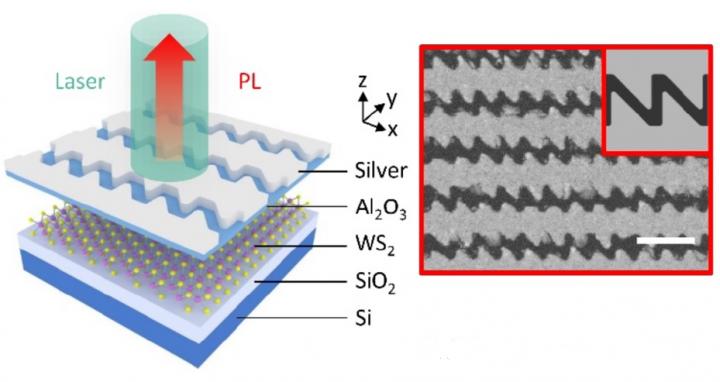Scientists make room temperature plasmon-exciton hybrid device

Silver sawtooth creates valley-coherent light in 2D Ws2 flakes
Scientists at the University of Groningen used a silver sawtooth nanoslit array to produce valley-coherent photoluminescence in 2D Ws2 flakes at room temperature. Until now, this could only be achieved at very low temperatures. Coherent light can be used to store or transfer information in quantum electronics. This plasmon-exciton hybrid device is promising for use in integrated nanophotonics. The results were published in Nature Communications on 5 February.
Ws2 has interesting electronic properties and is available as a 2D material."The electronic structure of monolayer Ws2 shows two sets of lowest energy points or valleys," explains Associate Professor Justin Ye, head of the Device Physics of Complex Materials group at the University of Groningen.
The picture above show how after excitation of the device with green laser light (green), coherent fluorescence occurs (red) thanks to the silver saw tooth (right panel). The scale bar is 500 nm.
One possible application is in photonics, as it can emit light with valley-dependent circular polarisation - a new degree of freedom to manipulate information. However, valleytronics requires coherent and polarised light. Unfortunately, previous work showed that photoluminescence polarisation in Ws2 is almost random at room temperature.
Valleys
"Ws2 is unique in that these two valleys are not identical,'" says Ye. This means that to create linearly polarised light, both valleys must respond coherently to generate light in the photoluminescence."But the intervalley scattering at room temperature largely destroys the coherence, so appreciable coherence is only achieved at very low temperatures that are close to zero."
Ye and his postdoctoral researcher Chunrui Han (now working at the Institute of Microelectronics, Chinese Academy of Sciences) therefore tried a different approach to create linearly polarised light by using a plasmonic metasurface, in the form of a silver sawtooth nanoslit array. Such a material interacts strongly with Ws2 and can transfer resonance induced by light in the form of an electromagnetic field in the metal. 'It enhances the light-material interaction,' says Ye.
Silver
By adding a thin layer of silver metasurface on top of a monolayer of Ws2, linear polarisation induced by the valley coherence is increased to around 27 percent at room temperature. 'This room temperature performance is even better than the valley polarisation obtained in many previous reports measured at very low temperatures,' says Ye. The linear polarisation could be further increased to 80 percent by adding the anisotropy of plasmonic resonance, in the form of the sawtooth pattern, to the optical response of the Ws2. This means that Ye and Han are now able to induce linearly polarised photoluminescence in this material.
This accomplishment will make it possible to use both valley coherence of Ws2 and plasmonic coherence of metasurfaces in optoelectronics at ambient temperatures. The next step is to replace the laser light that induced photoluminescence with electrical input.
'Polarised resonant emission of monolayer Ws2 coupled with plasmonic sawtooth nanoslit array' by Chunrui Han and Jianting Ye;.Nature Communications 5 February 2020.



































